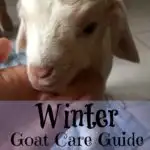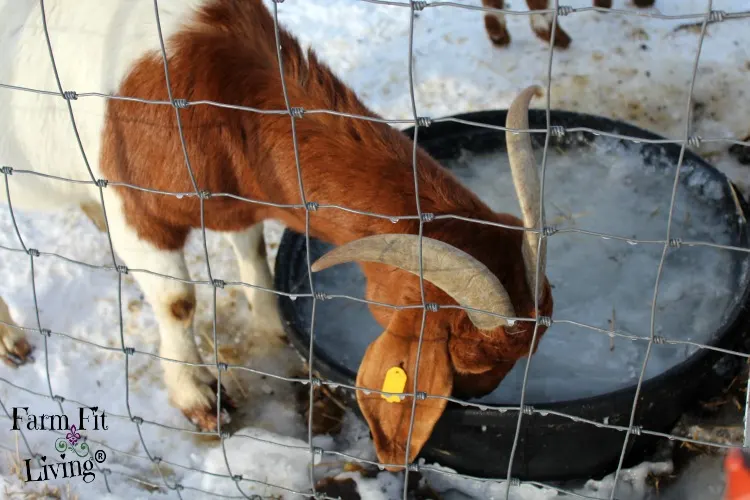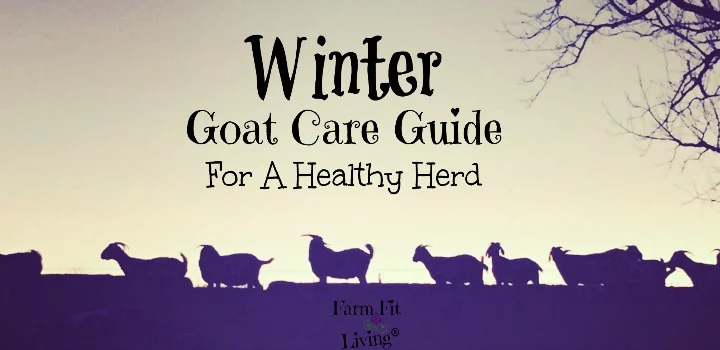Are you preparing your goat herd for winter by studying up on winter goat care?
Winter goat care is a different kind of care in regards to a commercial goat herd. Winter is the season that can make or break your profits. It’s a season to love and to hate with a PASSION! And Winter goat care can be easy or it can be hard.
**Read about how to raise them smarter not Harder**
So, it can be hard because goats prefer their owners to think they need more than they do. They are like the child in the store who want more ice cream, right? They look at you with their puppy goat eyes and beg to have more. More. And More.
Many goat producers do give goats more than they really need. But, the goats really don’t need extra. They just want it.
To make winter goat care easier, you have to simply just give goats what they need. Learn to be frugal with goat care.
Here What I Have To Say – Listen To The Podcast:
This post contains Affiliate Links. This means if you click and buy, I might make a commission at no cost to you.
See my policy for more information
Don’t give in. Know what your goats NEED.
To make a profit with goats, it’s important to recognize what they need. Not what they “want”.
From there, make a list of your REQUIRED inputs to budget. Keep track of all expenses and learn to cut back or even cut out items that don’t matter.
In this post, I will cover:
- My own complete winter goat care checklist.
- Answering the popular question: “Can Goats Handle the Cold?“
- Also answering questions, such as “How much do you feed a goat per day?“
Because it’s important NOT to “baby” your goat herd. Just give them what they need. This will improve your profits in the end if you’re interested in making money with goats.
Here’s 5 things for goat producers to monitor during the winter months.
1. Great Nutrition
The #1 winter goat care factor is absolutely nutrition. Especially if you choose to kid out goats through the winter like many producers do. Nutrition is the most important necessity to keeping any livestock through the winter months.
But, like I mentioned, stand your ground. Only give goats what they need. They will try to convince you they need more. Stay strong.
So, what do goats need? Well, it depends on the type of goats you are keeping through the winter. I’ll cover those classes of goats later on, so keep reading. But first, a good overview of nutrition.
What Do Goats Need?
All classes of goats need a diet of about 16% protein, which should include a good mix of energy and roughage. The calcium/phosphorus ratio in a good goat diet needs to be 2:1. Know what’s in the feed and roughage you are feeding your goats.
For example, a mixture of corn, soybean meal, oats, and molasses we feed is around 14% protein. We add in brome hay, which is around 6%. Now, we’ve exceeded the minimum protein content the goats will need to survive and thrive during the cold winter months. If they need more, we feed extra hay.
And if your goats aren’t doing much work (lactating, breeding, etc), they only need the minimum. For example, our non-breeding bucks only get hay, mineral and the cattle protein. They get all they want and maintain themselves through the winter.
Use local grains and products for energy sources to keep feed costs low. Talk to your local feed mill about buying a custom mix in bulk if you don’t want to shell out the money for branded bagged feed. Pick a bagged branded feed you are interested in, obtain a sample of a feed tag and see if your feed mill can reproduce it for you cheaper.
Also, goats need trace minerals in their diets ALL THE TIME. A loose, free choice trace mineral is important for proper nutrition. If goats are lacking in their trace minerals, you will have problems.
Here’s a neat mineral feeder you can make yourself that works well for feeding loose mineral.
Finally, after consuming all that mineral, they will be thirsty. The next thing goats need plenty of is water.
2. Plenty of Hydration
Goats need plenty of water during the winter months. Many people forget about water as a major nutrient. This is especially true for lactating does as they need a lot of water to make milk for their babies.
Now, we all know that providing water to livestock during the Winter is ANNOYING! Water is going to freeze. That’s a no-brainer. There’s no way around it.
It’s difficult to keep water handy for livestock when it’s always frozen, depending on your set up. I live in Kansas where winters can be tough, so I definitely know the struggles you face when watering your livestock in the winter. Here are a few tips I’ve uncovered in all my years of watering goats through the winter:
- Use rubber tubs in the winter that won’t freeze & bust.
- Keep something sturdy on hand, like a steel post, hammer or metal ice pick) for breaking the ice.
Winter Pro Tip: If you know the weather is going to be freezing, only fill the tanks half full. Give them only what they need in the morning and evenings. They will all come get a drink during those times and will be just fine. Again – It’s all about what they NEED.
You could also invest in an electric water heater. We have used them with success. The problem is that goats get bored and like to chew on things. Make sure that your cord is safe from goats before you decide to use an electric water heater.
Go Here to Read More About Watering Livestock During Cold Winter
Next, provide enough calories for your goats.
3. Enough Calories
I’ve discussed this briefly in the above nutrition section. I want to talk about how much to feed goats. I wanted to enforce this topic because it’s really easy to want to give goats more calories than they need.
Because goats only need what can maintain them. And that depends on how much they are working. It also depends on how cold it gets.
Again – Keep on reading and you’ll soon find out what those working classes of goats are. And how much nutrition they really need. The number of calories needed per animal varies on the size and amount of energy the animal is exploiting. The classes will help you to know how to slit and feed your goats into group and pens. It will help you know how to feed them enough but not too much.
But, since goats use quite a bit of energy in the winter months, it’s important to make sure they are receiving plenty of calories. It’s important to watch animals closely to be sure their body condition score remains consistent. I will cover body condition score in a later section.
And if I do need to give goats more due to extreme temperatures, I supplement in minerals and hay. Not grain because too much grain will cause some goats to founder. I fill the hay feeders another time and they can enjoy a little more protein to keep them warm through the extremes.
4. Winter Goat Shelter from Wind & Cold
Do goats need heat in the winter? Not really. The main thing that keeps goats warm is good shelter from the wind.
Type of shelter doesn’t matter too much. Use what you have and what works. Goats can actually really handle the cold temperatures rather well. They snuggle together and keep each other warm.
If you do build a shelter, such as a small building, needs to be secure. The winter shelter should face south out of the blowing snow and wind. EXCEPT when does are kidding. Then, type of shelter does matter. Shelter needs to be much warmer, maybe even enclosed.
Newborn, wet baby goat kids can’t handle temperatures less than 40 degrees Fahrenheit. You should really provide the warmest shelter possible or access to an enclosed building with heating unit for goats for newborn baby goat kids.
5. Understand Your Herd Health
For the most part, goat will adjust to the Winter cold very well. But some goats just can’t handle themselves in the wintertime cold. For reasons unknown, they don’t eat enough calories or maintain the nutrition they need to maintain their body condition score. And what happens is, they could make themselves sick.
Learn how to recognize this type of goat. They might be showing other off signs, such as:
- Isolation
- Not acting hungry
- Runny nose or cough
The first thing you want to do is look over that doe completely. Know the difference between lactating doe body condition score and open doe body condition score. Then, take the doe’s temperature with a digital thermometer. Her temperature should be between 101 degrees F and 103 degrees F.
Lactating does will appear to be thin if nursing kids. If this is the case, increase the amount of calories they are consuming. If you have an extra pen, you could put her and her babies in there to feed separately. Also, consider creep feeding the kids so they aren’t trying to overnurse mom.
On the other hand, open does should be able to hold their weight through the cold. If they cannot achieve that, then there’s is something else wrong. Separate the thin open does away from the group to fecal, deworm if needed and feed separately. With the change in environment, these does will either begin to add weight or they will need to be added to the cull list.
Read More About How To Figure Out Why Your Goat Is Sick
Understanding Body Condition Score
The body condition score (BCS) is a numbering system used to determine if the goats are holding good weight, maintaining, or could use more. It’s very simple to use. And since you know your goats the best, you use your best judgement to determine the care you give based on this BCS system.
Here’s the numbers and descriptions to note:
- 5: Goats look over fat. Feed them the minimum discussed above. Typically at 1% of their body weight.
- 4: Good Condition but a little heavy. Feed them the minimum amount.
- 3: Perfect condition. They need to maintain this condition through the winter. Just make sure you’re feeding the minimum but could increase if lactating.
- 2: A little on the thin side. Could increase protein and minerals to gain some weight. Obtain a fecal sample to check for parasites.
- 1: Thin! Can see ribs and back bone. Definitely take a fecal and start deworming. And feed extra feed and all the hay they want in a separate pen also. Consult a veterinarian if acting “off”.
Keep in mind that these numbers highly depend on the size and frame of the does. But, thin is thin and you should never ignore a doe that is BCS 2 or 1. It also depends on the work they are currently doing.
And Now: Understand the three different categories of goats and their nutritional needs:
Lactating Mothers – Mothers who are nursing kids need more calories. Hands down. Especially during the winter months. A rule of thumb for feeding lactating does in the winter months is about 3 % of their body weight. Also, consider starting the kids on a creep feed to take pressure off moms.
Breeding Bucks & Does – Breeding animals need a moderate amount of calories when they are breeding. This lasts for a short amount of time, so just be watchful of your breeding animals and how much they are working overtime. This group should consume at least around 1% of their body weight.
Young goats and Open does/Non Breeding Bucks – This group exerts the least amount of energy. They should be fed the minimum amount (less than 1% of their body weight) of feed possible and mostly roughage.
Winter goat care can be a lot simpler if you understand these classes and provide care accordingly. This knowledge will help you to provide the best winter goat care depending on the classes you have.
If you have all these classes together, you’ll find that some goats will get too much and others not enough. This is why I advise separating these classes and only providing what each class needs. Not only will it help your goats thrive, but you will enjoy winter much goat care much more.
Winter Is GREAT!
It’s time to love and embrace winter when it comes to raising goats. If you simply graze goats through the spring, summer and fall months, the extra work is feeding pregnant and lactating does.
But I actually enjoy winter goat care for a few reasons:
- Parasites aren’t really a problem in freezing temps. But do watch out for Coccidiosis and lung worm.
- I get to spend a lot of quality time with my goats.
- Immune systems seem to thrive during the cold months, too.
So, there really are some great things about the winter months. And now, you have some resources to try to make Winter goat care easier for you.
Because, finding a way to get through the winter leads to healthy goats and deeper pockets preparing for the grazing season. It takes preparation, planning and lots of watching. So, get out there, implement some new proven techniques and enjoy the cold weather.
Please comment with your winter goat care techniques!







